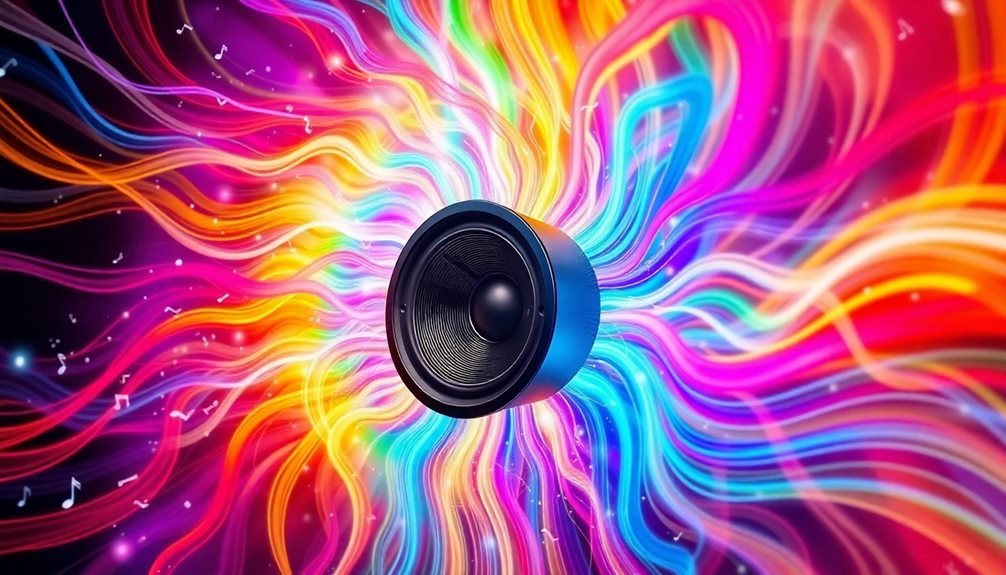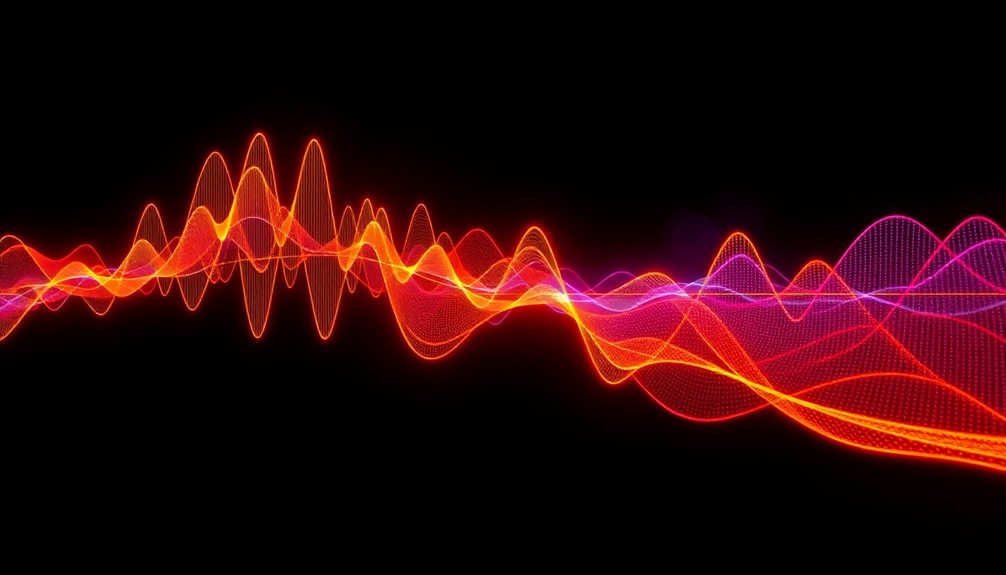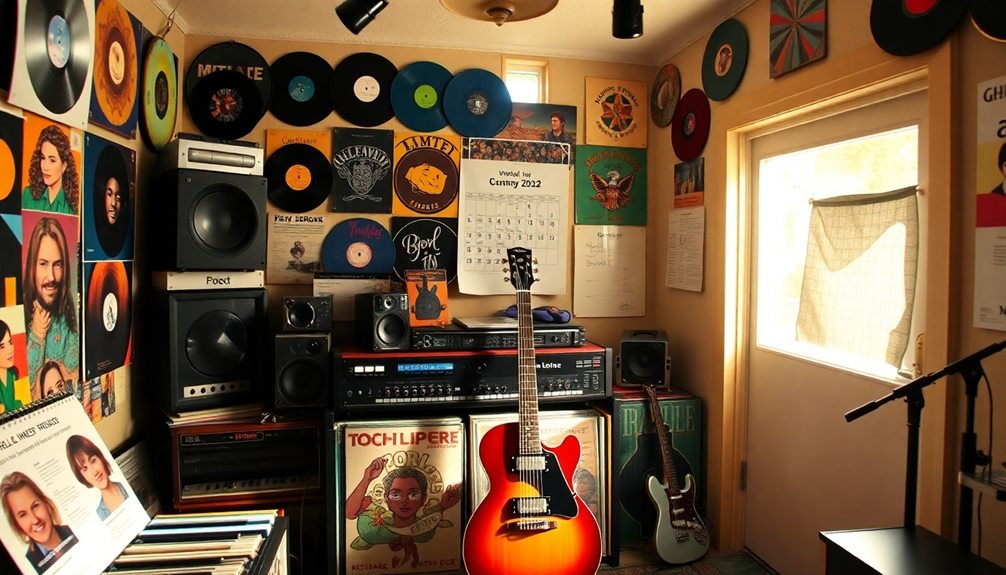Sound frequencies are super important because they shape what you hear every day. Measured in Hertz (Hz), frequencies range from 20 Hz to 20,000 Hz. Lower frequencies create deep, rumbling sounds, while higher ones produce bright, cheerful tones. Your ears are best at catching sounds between 2 kHz and 5 kHz, which helps you enjoy music and understand speech. Different frequency ranges bring different feelings; for example, powerful bass can make you want to dance! Understanding sound frequencies opens up a world of fun, whether it's music, nature, or even technology. Stick around to explore more exciting details!
Key Takeaways
- Sound frequencies are measured in Hertz (Hz) and range from 20 Hz to 20,000 Hz in human hearing.
- Lower frequencies produce deep sounds, while higher frequencies create bright tones important for speech and music.
- Effective frequency management is essential in audio engineering to avoid listener fatigue and ensure clarity.
- Harmonics enrich sound quality, affecting the timbre and fullness of music and audio experiences.
- Prolonged exposure to high-intensity sounds can lead to hearing damage, necessitating awareness and protective measures.
Overview of Sound Frequencies
Sound frequencies play an essential role in how we perceive the world around us. They're measured in Hertz (Hz), and our human audible range typically spans from 20 Hz to 20,000 Hz.
You might be surprised to learn that lower frequencies, like the deep rumble of a bass drum, fall between 20 Hz and 250 Hz, while higher frequencies, such as the sparkle of a flute, soar from 2 kHz to 20 kHz. Each part of the frequency spectrum brings something unique to sound perception.
Pitch and tone are directly linked to these frequencies. For instance, the lowest A on a piano is 27 Hz, creating a deep sound, while the highest C reaches 4186 Hz, producing a bright tone.
Your ears are especially sensitive to sounds between 2 kHz and 5 kHz, which is essential for understanding speech and enjoying music.
Understanding frequency ranges is critical for audio engineering and sound reproduction. If not managed well, it can lead to listener fatigue or unclear sounds.
Measuring Sound Frequencies

Measuring sound frequencies is a critical process in audio engineering and acoustics research. It helps you understand how sound works and improves the quality of what you hear.
There are different methods for measuring sound frequencies, like n-octave filtering and the Fast Fourier Transform (FFT). These methods let you see how sound behaves in different situations.
Here are three exciting tools you might use:
- Sound analyzers with special microphones help capture sound accurately.
- Sound level meters can analyze sounds in 1/1 or 1/3 octave bands, showing how different sounds mix.
- Frequency response charts visually represent how well audio devices reproduce various audio frequencies.
Accurate measuring of sound frequencies is essential. It helps researchers and engineers identify frequency components in complex sounds and optimize sound quality.
Specialized devices like the SV 977 measure ultrasound frequencies, while the SV 971A focuses on audio frequencies. By understanding frequency analysis, you can really appreciate the beauty of sound and the technology behind it.
Importance of Frequency Ranges

Understanding sound frequencies goes beyond just measurement; it involves recognizing the significance of different frequency ranges in audio production and perception.
The audio frequency spectrum spans from 20 Hz to 20 kHz, matching what humans can hear. This range is essential for sound quality and how we experience music.
Let's break it down! Sub-bass frequencies, from 20 Hz to 60 Hz, are felt as vibrations. They create a solid foundation in genres like hip-hop and electronic music.
Next, bass frequencies (60 Hz to 250 Hz) add warmth and power, enhancing the overall feel of a track.
Now, midrange frequencies (250 Hz to 2 kHz) are critical for clarity, especially when it comes to voices and instruments.
The upper midrange (2 kHz to 4 kHz) is particularly sensitive for human hearing, but if it's too loud, it can lead to listener fatigue.
Applications of Sound Frequencies

While many people associate sound frequencies primarily with music, their applications extend far beyond entertainment. Sound frequencies play an important role in various fields, like medicine, industry, and wildlife research. Here's how they impact our lives:
- Ultrasound: In medicine, sound frequencies help doctors peek inside our bodies without surgery. This non-invasive imaging technique uses high-frequency sound waves, allowing for safe examinations.
- Industrial Uses: In geophysical research, low-frequency sound waves, known as infrasound, help scientists find underground resources and monitor seismic activity. This can keep us safe during earthquakes!
- Telecommunications: Sound frequencies are vital for voice communication. They help transmit our voices over phone lines, ensuring we can chat with friends and family from anywhere.
Plus, in wildlife research, scientists study how animals, like bats, use sound frequencies to communicate and navigate.
Understanding these applications can truly enhance clarity in our lives, from keeping us healthy to connecting us with others. Isn't it amazing how sound frequencies shape our world?
Harmonics and Audio Quality

Sound frequencies not only serve practical purposes but also influence the quality of the sounds we hear every day. Harmonics, which are integral multiples of a fundamental frequency, add richness to music and sounds. They play a big role in creating high-fidelity audio, making the listening experience enjoyable.
Here's a quick look at how harmonics affect sound:
| Aspect | Description | Impact on Audio |
|---|---|---|
| Perceived Timbre | The unique character of a sound | Makes instruments sound fuller and vibrant |
| Clarity of Sound | How clear and distinct the sound is | Enhances the overall listening experience |
| Harmonic Distortion | Unwanted changes in sound caused by improper balance | Can lead to listener fatigue and discomfort |
Audio engineers carefully manage harmonics within the frequency spectrum. They understand that the right balance is essential for great sound design. Too much harmonic distortion can make music harsh and unpleasing. So, when you enjoy your favorite tunes, remember that harmonics are working hard behind the scenes to create that amazing audio quality you love!
Health Risks From Sound Frequencies

Have you ever thought about how sounds can affect your health? High-intensity noises, especially those above 85 dB, can hurt your hearing over time.
Plus, certain frequencies can make you feel uncomfortable or even cause problems with the places around you, so it's super important to know how to protect yourself!
Hearing Loss Risks
Prolonged exposure to high sound levels can silently threaten your hearing. You mightn't realize it, but sounds above 85 decibels can lead to noise-induced hearing loss. This risk increases in the frequency range of 2,000 to 4,000 Hz, where our ears are most sensitive.
Here are three key reasons to pay attention:
- High frequencies are often the first to go, especially as you age. By the time you're in your 60s, you might struggle to hear those sounds.
- Low-frequency sounds can be uncomfortable and even cause structural damage if they're too loud for too long.
- Acoustic trauma from sudden loud noises, like gunshots or explosions, can cause permanent hearing damage.
To protect your ears, consider using hearing protection like earplugs or noise-canceling headphones when you're around high sound levels.
Regular hearing assessments can also help you catch any issues early.
Frequency Sensitivity Effects
When it comes to frequency sensitivity, your health can be greatly impacted by the sounds around you. Sounds can be loud, soft, high, or low, and each has a different effect on your hearing health. Prolonged exposure to noise levels above 85 dB can lead to noise-induced hearing loss, especially in the frequency range of 2,000 to 4,000 Hz. This is where our ears are most sensitive!
Low-frequency sounds, which are below 20 Hz, can make you feel uncomfortable and even cause strange physical sensations. High-intensity noise, like what you hear at concerts, can reach dangerous levels of 125 dB, pushing you closer to pain! It's crucial to protect your ears in these situations.
The resonance frequency of buildings can also amplify sound effects, which may harm both your hearing and the structural integrity of the space.
Understanding how different sound frequencies impact your health helps us create better sound insulation materials and workplace safety rules. So, be mindful of the sounds around you! They can have a real health impact that you mightn't even notice at first.
Future Trends in Sound Design

As sound design evolves, you'll likely see exciting advancements that enhance your listening experience. Imagine diving into an ocean of sound with immersive audio technologies like spatial audio. This makes music feel like it's swirling around you!
Plus, AI-powered audio tools are streamlining the creative process. You'll benefit from smart equalizers and automated mixing software that help achieve stunning sound quality.
Here are three trends to look forward to:
- Higher quality streaming: Enjoy lossless audio formats that keep the original recordings intact, so you hear every note and whisper.
- Psychoacoustics: This research helps designers craft soundscapes that evoke emotional responses, making your listening experience even more engaging.
- Eco-friendly materials: As manufacturers seek sustainable options in sound equipment design, you'll get high-quality audio that's kind to our planet.
These trends promise to transform how you experience sound, bringing joy and excitement to your favorite tunes. So, get ready to embrace the future of sound design—it's going to be a thrilling ride!
Frequently Asked Questions
How Do You Interpret Frequency of a Sound?
To interpret the frequency of a sound, you listen for its pitch. Higher frequencies sound sharper, while lower frequencies feel deeper. You can use tools like FFT to analyze and visualize these sound components effectively.
How to Know What Frequency a Sound Is?
Imagine diving into a sea of sound! To know a sound's frequency, you can use tools like sound analyzers or frequency counters, measuring Hertz (Hz) to reveal the hidden rhythm of those waves.
What Are Sonic Frequencies?
Sonic frequencies are the range of sound waves your ears can hear, typically from 20 Hz to 20 kHz. They determine the pitch of sounds, affecting how you experience music and other audio.
Does Higher Hz Mean Better Quality Audio?
Higher Hz doesn't automatically mean better audio quality. While they can enhance clarity, balance across frequencies is essential. If you prefer a well-rounded sound, consider both high and low frequencies for the best experience.
Conclusion
To sum up, sound frequencies are all around us, shaping our experiences and enhancing our lives. By measuring these frequencies, we can understand their importance, explore their applications, and appreciate how they affect our health. From music to technology, sound frequencies play a key role in everything we enjoy. As we look to the future, let's embrace the exciting possibilities sound design brings. So, keep listening, keep exploring, and let the world of sound inspire you!









